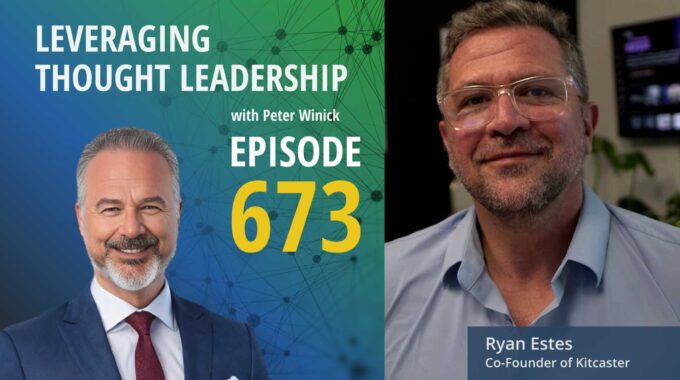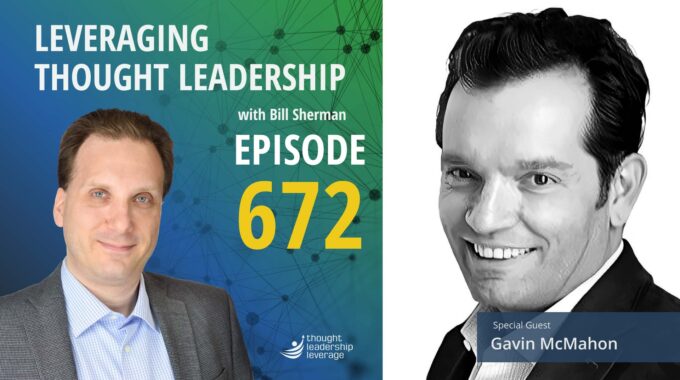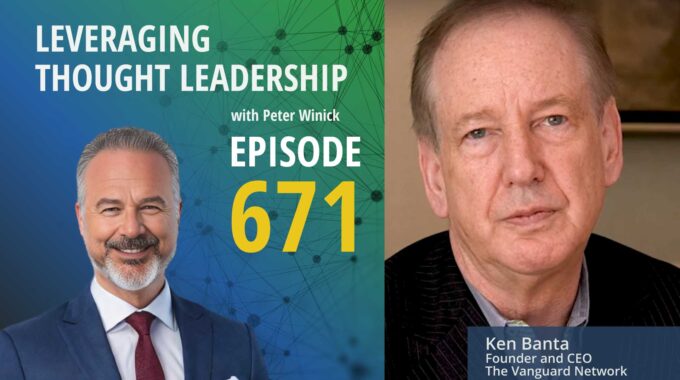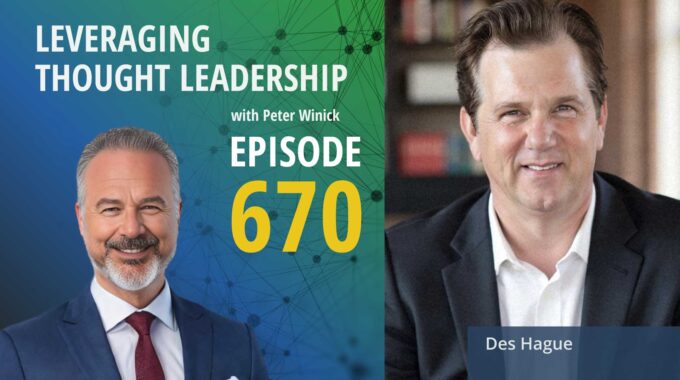Founder-led marketing, podcast strategy, and the art of authentic conversation What makes a podcast truly…
The Secret to Landing More Speaking Gigs | Cam Beaudoin
spe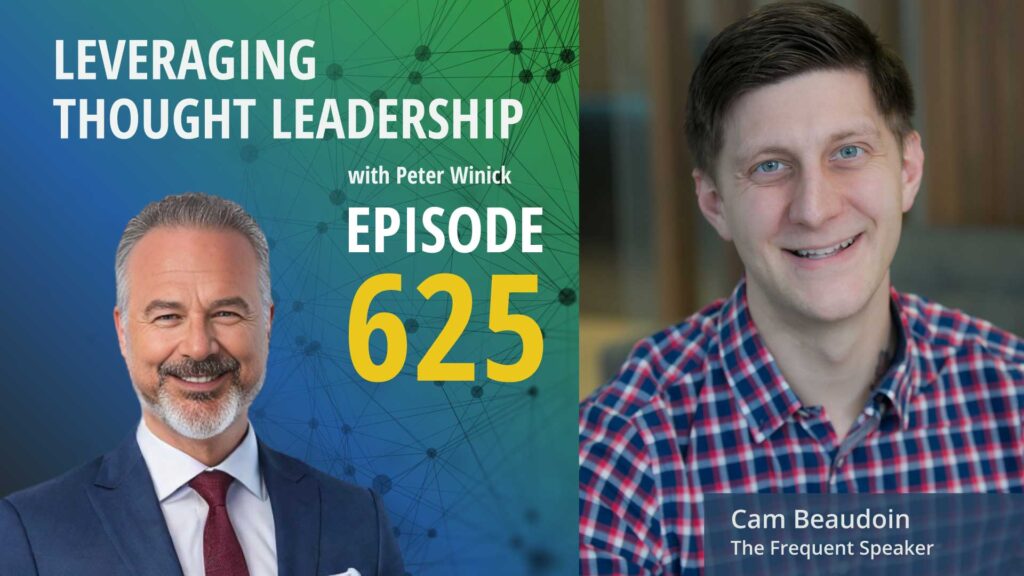
Why a Great Demo Reel is Your Ticket to the Stage
Want to get booked as a speaker? Cam Beaudoin reveals why most speaker reels fail—and how to create one that grabs attention and gets you hired. Learn the secrets to positioning yourself as the perfect choice for event planners, even if you’re just starting out.
How do you get booked as a speaker when no one knows you? And how do you stand out in a crowded market?
Cam Beaudoin has cracked the code. A former speaker on disability inclusion and accessibility, Cam now helps speakers create powerful demo reels that get them noticed—and hired. He joins me on Leveraging Thought Leadership to share why most speaker reels miss the mark and what you need to do instead.
We break down the myths about demo reels, why a flashy highlight reel won’t get you booked, and how to craft a video that makes event planners say, “This is the speaker we need.” Cam also reveals a simple yet overlooked strategy to build credibility—even if you don’t have a big-stage clip yet.
If you’re a speaker (or want to be), this episode is a masterclass in making yourself irresistible to event organizers.
Three Key Takeaways
Your speaker reel is a sales tool, not just a highlight reel. It should clearly show how you solve a problem for event planners and their audiences.
You don’t need a big-stage clip to create a compelling reel. Interviews, media appearances, and even small-stage footage can establish credibility and showcase your expertise.
Getting booked isn’t just about great content—it’s about marketing. A strong demo reel gets you the call; your job is to convert that into a paid speaking gig.
If you want some additional tips to make your demo reel sizzle, check out this article by Leveraging Thought Leadership COO Bill Sherman.
Transcript
Peter Winick And welcome, welcome, welcome. This is Peter Winick. I’m the founder and CEO at Thought Leadership Leverage. And you’re joining us on the podcast today, which is Leveraging Thought Leadership. Today my guest is Cam Beaudoin. Cam is interesting in that he coaches speakers to maximize their lead pipeline and he does some really cool stuff with demo reels, which that’s evolved over the years. So without further ado. Welcome aboard, my friend. Welcome, Cam!
Cam Beaudoin Hey, Peter, Thanks so much for having me. This is going to be great, I think.
Peter Winick Yeah, well, I hope so. Not, you know, but we’ll do something else.
Cam Beaudoin Well, we’re everything off each other. What we were doing the pre call like, like a week ago. So I think this is it’s this can be offset. I think it’s going to be really great.
Peter Winick Yeah. So you and I were chatting and I really liked your thinking in perspective. So give us sort of a high level overview of the type of work you do. One is that you’ve been a speaker, you are speaker, but then how did you how did you find the opportunity that you did in this in the speaking space? Because I think it’s kind of interesting.
Cam Beaudoin Yeah, sure. So I was a speaker for about seven years on disability inclusion and accessibility, and those are pretty big words. But it all kind of boils down to can technology be used by people with disabilities? Like that’s pretty much if you’re blind, how do you interact with your phone if you’re if you’re deaf like our videos, do, videos have subtitles and things like that. So that’s pretty much what I would go and speak on and kind of evangelize what it is to for my for my peers, my colleagues, my friends who have disabilities, you know, how do I evangelize them and make sure they’re at the forefront when people are building out technology?
Peter Winick So and so that’s how will generally good topics from not just from the topic, but from the standpoint of you’ve really clearly defined your niche. Absolutely right. When I look at you, I’m trying to extrapolate the template in the model of how speakers can figure out sort of how to navigate the way.
Cam Beaudoin Yeah, yeah. And isn’t it funny, I’m sure you have the same conversation with a lot of people that you help as well when they go and say like and you asked them, who do you help? And they say everyone. And you’re like, Wait, we got some other work to do here. We got we got some stuff to work on here.
Peter Winick That is my unfortunately, a fairly common answer, but I actually think the worst answer anyone could give.
Cam Beaudoin Right, right, right. Yeah. So the middle of the pandemic, I kind of realized I said, you know what, let’s let me give a real kick the can here. And so I like elevate and improve my public speaking skills. In fact, I went out and first looked for voice coaches who could help me remove ums and others from my talk because I thought that was just kind of slowing everything down. Anyway, the reality is you just got to slow down your talk. And for anyone who’s looking at and not just slow down and take a pause for a second. So through that process, I joined some speaker programs and how do I want your business? And I found that everyone, all my friends, they were getting so hung up because all these speaker programs, they say you need a memorial, you need a website, you need all this kind of like ancillary extra stuff that needs to get created for speaking business.
Peter Winick There’s a little bit of a, you know, who got rich during the, you know, the gold rush. You know, you’re selling pickaxes. So a lot of and I’m not digging anyone specifically, but there’s a whole cottage industry of quote, supporting speakers and some of them about stuff that they may need or not need. So that’s one thing I would be somewhat I wouldn’t say skeptical, but somewhat pessimistic about. Right. If you want to get this space, step one is and spend a zillion dollars on every bell and whistle. But I think. You know, you sort of the next place you’re going is okay. Well, you know, you speak a real okay. Well, if I haven’t spoken anywhere, how do I get to speak Israel? So there’s a bit of an egg problem where if you’ve been speaking for a long time and want to upgrade, you feel like you should do on a regular basis or whatever the case may be. That’s a fairly easy process. But if you don’t have the footage that was sort of the thing that you scratch your head and said, I hear in lies an opportunity. So what did you what did you come up with?
Cam Beaudoin Well, I think a big part of a demo reel, a good one, is that are you solving a problem? Are you clearly communicating a problem that you can help solve for that event plan for their audience? And you know, what else I found is that can you articulate the problems of an event’s audience better than the person who’s hiring you? Like that is like a really big, like, key factor in all of this. So what I said is, well, why not just put a speaker in front of a camera and go and find some really cool location where they can go and record themselves in a cool location, can be a really funky auditorium or it can be like a theater studio, right? What if I just ask a bunch of questions about their business and who they help solve and then add that into 2-to-3-minute video that clearly defines who they help, why they’re there, that position themself as the guide to, to really, you know, guide an event organizer to.
Peter Winick Yeah just because I think this is a place where not only new speakers but even experienced speakers sometimes missed the mark where a speaker real is not just look at me, look at me. It’s not a highlight reel of sports right where you’re writing. The big homeruns I hit or the plays that I made, I think that’s somewhat egocentric is, here’s my best of right. That’s there are elements of that that need to be in a speaker role in terms of can you can you see audience reaction? Can you see a big arena, small arena, etc.. But I think I love the idea of sitting down and having a conversation because if you look at it through the lens of the event planner or whoever panel the event is hitting, what are they trying to achieve? And it’s not they didn’t get 500 people together to create an audience for you to have a fun time for an hour. That’s not what they did. They have a business goal and the business might be doing well or not. So while it might have went through some changes or some act, whatever the stuff is and the question, you know, the trick is you’re just a tool to help them raise a level of awareness, a discussion, a conversation, an insight, etc., and then you go home. Right? So I think I just you format where you get to be more human than just a keynoter from an entertainment standpoint, then the buyer can go, that’s interesting. Yeah, they can adjust that message to meet where I am today.
Cam Beaudoin Exactly right. A speaker demo reel is a sales asset. Right. We have to get it out of our minds that you just like what you said. It’s not a highlights reel. The demo really doesn’t get you booked for the gig. I never heard a speaker saying, because I. You know, I’ve got this three-minute video I got booked. No, no. It gets you to call with the event planner. Then your job is to go and convert that into a sale. Right? So what does that do? It really creates interest in the event planners mindsets, like you said, this person looks like they could solve the problem that my people have, that, you know, the transformation that we’re going through, they can help ease our way through this transition. Let’s get them on the call. Let’s get the speaker on the call to see if they can come help us more.
Peter Winick One, I think it’s that and I would add to it that in most instances today, the decision to book a speaker is not a one-person decision. Now, when some years ago, more things than we’d like are done by committee. So if you are person one, right, and you were in Las Vegas and you saw this great speaker and you come back to your team to, man, I saw this guy Cam and he’s great and I at it, I might lose something in the translation. But what was great about him was that his content was it his energy was at his delivery. So I might not be able to articulate that well. Right? So now the real also sort of neutralizes the game of telephone because that gets passed around internally amongst the decision makers. So now when we’re all saying I saw Cam and he at a good energy level, assuming they also the video they go yeah kind of get that you know he’s likable. He’s got empathy. He’ll resonate with our culture.
Cam Beaudoin Yeah, exactly. There are 3 to 5 people on average now that need to make a decision on a speaker. And especially when you start to look at the five figures, you know, ten, 15,000 plus, you know, it’s not just let me cut a check. It’s let me make sure there’s value in bringing this person in. And I think there’s like that actually creates opportunity to me. That’s why I become so valuable like that. That’s why you can set yourself apart and how you can set yourself apart by pointing that message and then like saying, I’ve got this video, I’ve got this speaker kit. Like, I’ve got all my components together. Everything you need to make a decision on me is all right here in this nice little package.
Peter Winick And I think the other thing that folks need to convey as a speaker is it’s not just the can think, right? Here’s the 45-minute speech, etc.. But you need to be able to convey that. I want to understand where your business is. What do you want me to accomplish for you? What does success look like for you? What are the points that you want me to raise? What are the things you want me to avoid? Etc.? Not that it’s a one size fits all. You know, the performance is at 2:00, you know, and it is what it is. And I think you can do that through a real. So. Right, right.
Peter Winick And if you’re enjoying this episode of Leveraging Thought Leadership, please make sure to subscribe. If you’d like to help spread the word about our podcast, please leave a five-star review at ratethispodcast.com/ltl and share it with your friends. We’re available on Apple Podcasts and on all major listening apps as well as at ThoughtLeadershipLeverage.com/podcast.
Peter Winick And one other question I have for you relative to the reels. Is pre-COVID a real met one thing and today it doesn’t. Right in pre-COVID was a showed you in a variety of audiences in a variety of formats probably highlighting a bunch of cool logos of big organizations, etc. Audience reaction. You can sort of see the template now, you know, we went immediately during Covid and shortly thereafter to much of what is being delivered is remote. Now it’s sort of hybrid. So how do you show both or do you show both on both the live and the and the remote element? Well.
Cam Beaudoin Let me just back up one second, because there’s one thing you said before. Covid, a devil rule is like 5 to 7 minutes. Now it’s like two. So before we talk about anything else, tick tock, Instagram. Like all this talk from content has really shortened our attention spans to watch videos. People just want to make a decision, Do I get on the call with this person or not? Like, that’s it. So first off, first thing you got to do is make sure it’s tight. It’s really, really, really tight. So second to that. Yeah, there’s a higher well.
Peter Winick Just stay there one second. I don’t mean to interrupt you, but I think what I’ve seen happen is speakers obsess over their I mean, like, obsess over every frame and every this and every like almost at a level of OCD. And I think that’s important to have a high-quality bar. But I think you also have to have in your mind, well, what is the use case? And this is a two-minute video and someone’s got a meeting to go to and they have to prep for it. They might be watching it on their phone in the elevator. Right. Not sitting in front of like you are in your office, your big fat screen.
Cam Beaudoin Right.
Peter Winick Etc.. I think you have to understand sort of, okay, well, how are people actually using this and why? And then when you sit there with open say, that colored blue shirt, I would have liked a paler blue shirt, you know.
Cam Beaudoin Yeah, Yeah. What’s it called? Up. Down is better than perfect, right? Just get it out there. Like, that’s the most important thing. And so you nailed it with that. You know, people are sharing this over Zoom like you’re getting if you’re in a large corporate environment. You got four people around in a boardroom and they’re playing it on the screen. That’s like, you know, 12ft away. So you’re just not see, it’s not up on big screen. You’re not listening to headphones, generally speaking. Yeah, that’s kind of how the viewership is going. So before I start, I was going to talk about the hierarchy of like what’s most important, because you ask, who do we add virtual conferences? So yeah, if you’re presenting something that’s super stand out, of course I’m going to add that in there. But there is a hierarchy of what event planners are looking for. Yes, Number one’s got to be stage, you know, stage performances. You don’t have that. It’s cool that you have media appearances. Have you been on the news or you’ve been featured anywhere? If you’re like that, like that looks really good as well because that’s just providing social proof that as other people are giving you authority, right? So that’s number two. Number three is that interview. So I’ve had reels where speakers have come to me. They’ve got like 2 or 3 virtual performances. But then because we’ve added in that interview, it like really bumped up their performance. Next up is like workshops. So things where maybe you weren’t miked up properly because, you know, like a corporate workshop, you’re not miked up. You’re kind of just yelling out in front of the audience. Yeah, that looks really great. As again, audience interaction showing other people have hired you, stuff like that. And then kind of down from there, virtual appearances, webinars, panels, things like that. Everything else is kind of added on. But if I’m going to throw together a two minute, three minute reel, then I’m putting a lot of weight behind the first four, right? So, so stage performances, interviews, media appearances, live panels and stuff like that.
Peter Winick So let’s go back to the chicken and the egg piece or how do you solve the problem of I don’t have the stage stuff or I don’t have a lot of it or enough of it or the audio was and, you know, I’m a beginning speaker. It’s my first 20 gigs or something like that. How do you solve that? Chicken and egg. Problem. Well, you got to start where you are.
Cam Beaudoin And I think that a lot of speakers, you know, I have I have over 100 stages under my belt. I cannot go and say I’m a $25,000 speaker. Like, I just can’t do it. I just can’t do it. So I think a lot of speakers have to really take a take a perspective of where you are right now. Like if you’re still building your signature talk, you’re probably not going to go out there and get a ten or maybe $10,000, but maybe like a 15 or $20,000 talk, right? So wherever you are right now, you have to use what that material is to get it mixed up. Yes. You can go record your interview. Yes, you can go find a Chamber of Commerce stage to go do it at event. Planners are getting wise now. They can start to pick out. I’ve spoken to many now who’ve said, you know, I’ve seen three speakers all at the same stage. So there’s some organizations out there that will put a bunch of speakers on stage and they’re like, Why is it what dress to save? And like, I’ve seen 3 or 4 speakers at that same background, so they’re getting wise towards it. So it doesn’t mean you can’t do that. You just got to make it look like a performance. Like you’ve got to get out there and give it your all. So work with where you are right now and then use that to leapfrog into doubling your speaker, right? Like if you’re going from 2500 to 5000, you’re doubling your rate, right? And then you take a bunch of talks at 5000, you’re going to have 1 or 2 good stage performances go by. Go invest in the lapel. Mike going hire your own videographer team. It’s like 600 bucks. If you’re not willing to invest $600 into your business, you should be like, What? Like, where are we going with this? Right? So then you can like, leapfrog got up to $10,000, then you get some, then you get like real footage. You’re getting some real performance.
Peter Winick Well, and the irony of the speaking business is it’s far easier to sell a $25,000 speaker than a $2,500 speaker. True love. Yeah.
Cam Beaudoin It’s not a bullet. It’s not like a business fact of all things like, you know, your best clients are going to be the ones that pay more than those ones that I like. Yeah, sure.
Peter Winick Yes. And but, but I think what’s different is when you’re at that, let’s say 15, 15 plus level 15, 20, 25.
Cam Beaudoin Yeah, definitely a division at that 15 down starfield.
Peter Winick Yeah. The buyer is more sophisticated. It’s not a nonprofit or an association with a board. And like, you know, the reality is for a $2,500 speech, you can’t afford to do, you know, eight, ten recalls to sell it. Right? You have to buy it is just the math doesn’t work. It just doesn’t. And the higher your ticket price, the easier it is to sell. So the question is, how do I shorten the time that I’m stuck at the $5,000 level, right. To get ten in the 15, etc.? Well, has been great. Any final tips for those that are out there that are like thinking about diving in or kind of early and like what? What might you suggest to them?
Cam Beaudoin I would say record everything. Like stop being afraid of your own content to just get out there in the hour volume you create of content. And like I say, even if you just go to a talking, you hand your phone to the person in front of you and say, Just record me like doing this. Yeah, that’s going to be good content for you to use elsewhere. Good content using your real on socials no matter what. Because if you think about your content, just get to the call with the decision maker or decision makers, right? In some situations, you know your biggest lever is going to be can you just get better at that call as well? So be focusing in on on like the business and sales aspect of your talk and then not say don’t focus on your talk, but it’s going to make you going to see a lot more difference if you focus in the early stuff.
Peter Winick Low It is great stuff. Kim, I appreciate your time and your energy and your expertise. Thank you.
Cam Beaudoin Cool, man. Thanks for having me.
Peter Winick To learn more about Thought Leadership Leverage, please visit our website at ThoughtLeadershipLeverage.com to reach me directly. Feel free to email me at Peter at ThoughtLeadershipLeverage.com. And please subscribe to Leveraging Thought Leadership on iTunes or your favorite podcast app to get your weekly episode automatically.


